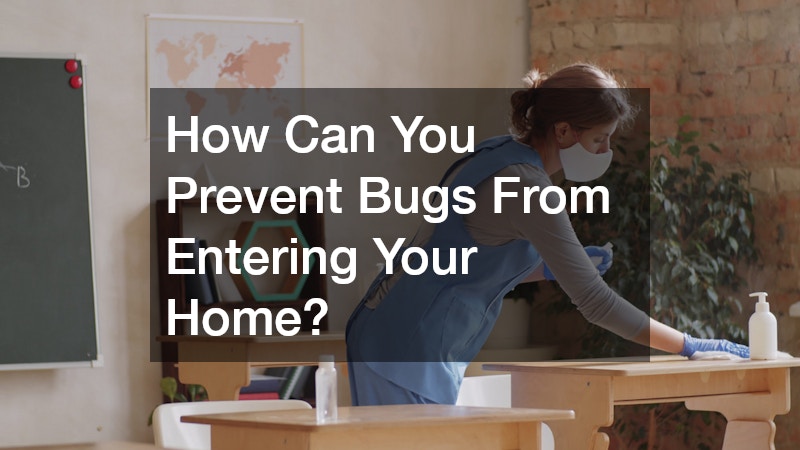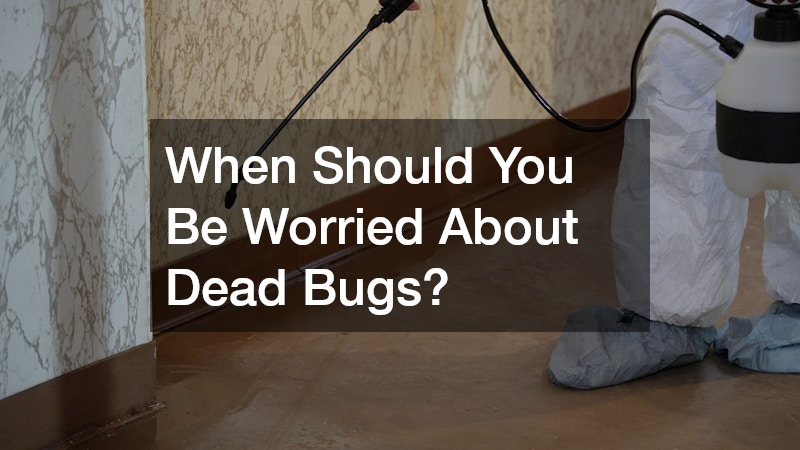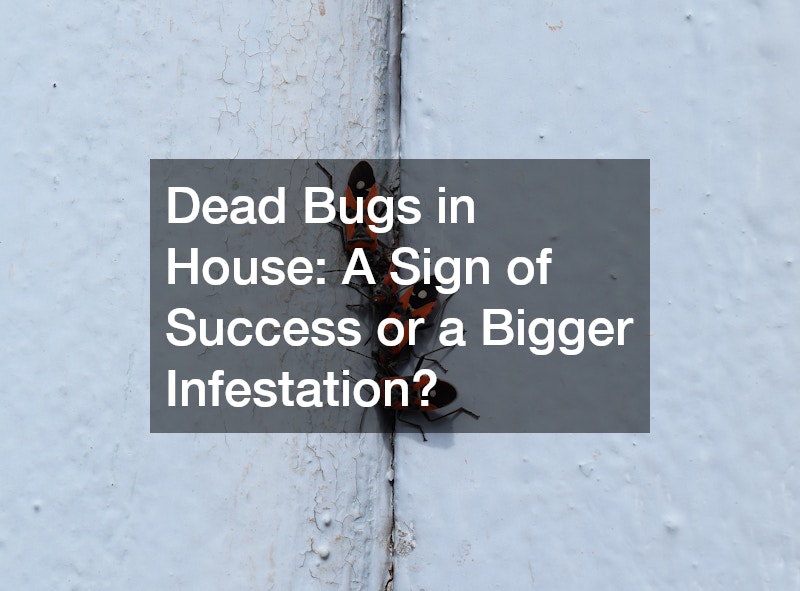Discovering dead bugs in house can be an unsettling experience for homeowners. While some might assume that finding them means a pest problem is escalating, others may see it as a sign that previous pest control measures are working effectively. The truth often lies somewhere in between. Dead insects can indicate successful extermination, the presence of natural predators, or the initial stages of a larger infestation. Understanding what dead bugs in house signify requires knowledge of pest behavior, common household pests, and the factors that contribute to infestations. From ants and cockroaches to termites and rodents, different pests leave different traces behind, and knowing what those signs mean can help homeowners respond appropriately. Furthermore, integrating preventative measures like regular inspections, natural termite control, and proper maintenance can minimize future pest encounters. Consulting professionals such as an exterminator or ant exterminator can also provide guidance on whether the appearance of dead bugs indicates a resolved issue or the need for more aggressive intervention. This article explores the science, myths, and practical steps surrounding dead bugs in house to help homeowners make informed decisions.
What Do Dead Bugs In The House Indicate?

Common Interpretations Of Dead Bugs
Many homeowners have preconceived notions about dead bugs in house. Some believe that seeing dead insects automatically indicates a serious infestation, while others think it’s proof that pest control treatments are working. In reality, the presence of dead bugs can mean different things depending on the type of insect, its lifecycle, and the overall condition of your home. For example, a few dead ants near a food source might indicate a minor ant problem, whereas dead cockroaches scattered in multiple rooms could signal a larger infestation. Popular myths suggest that dead bugs are purely cosmetic or that removing them isn’t necessary, but this can overlook potential underlying issues such as moisture problems or structural vulnerabilities. By understanding the nuances, homeowners can better determine whether dead bugs are a warning or merely the result of effective pest management.
Scientific Perspective On Dead Insects
Entomologists note that dead bugs in house are often the endpoint of natural life cycles or successful pest control efforts. Certain insects, like ants or termites, die naturally after completing tasks such as foraging or mating. Dead bugs may also indicate the effectiveness of professional treatments by exterminators or ant exterminators. Insects are sensitive to environmental changes, including humidity, temperature, and chemical exposure, so their mortality can reflect broader conditions in your home. Additionally, the presence of dead bugs can sometimes alert homeowners to infestations in hidden areas such as wall voids, attics, or basements. Observing patterns in where dead insects appear can provide valuable insight into the scope and type of pest problem that may exist.
Link Between Dead Bugs And Infestations
Dead bugs in house do not always equate to a current infestation, but they can be an early warning sign. Regular sightings, especially in multiple rooms, may suggest that pests have established nesting sites. For example, consistent dead ants in a kitchen corner might hint at an ant colony nearby, while multiple dead cockroaches in a basement or bathroom could indicate a hidden breeding ground. The relationship between dead bugs and active infestations is complex, involving factors such as environmental conditions, the effectiveness of previous treatments, and the presence of natural predators. Professionals like local wildlife removal experts and exterminators often advise monitoring these patterns before deciding on a full-scale intervention.
How Can You Differentiate Between A Few Dead Bugs And An Infestation?
Signs Of A Small Problem Vs. An Infestation
Not all sightings of dead bugs in house should cause alarm. Small problems are usually limited to a few insects, localized in one area, and occur sporadically. Infestations, on the other hand, show recurring appearances of dead bugs in multiple locations and may coincide with live insects, droppings, or damage to property. Characteristics that suggest an infestation include clustering of dead bugs, evidence of gnawing or burrowing, and visible damage to wood, fabrics, or stored food. Paying attention to these details can help homeowners decide whether to attempt initial remedies like improved sanitation or to consult a professional exterminator for more targeted ant extermination or wildlife removal.
Behavioral Patterns Of Pests
Understanding pest behavior is essential for interpreting dead bugs in house. Different insects exhibit distinct patterns of movement, nesting, and reproduction. For instance, ants follow pheromone trails, so clusters of dead ants may indicate a disrupted colony or successful ant exterminator intervention. Cockroaches tend to hide in dark, damp areas, so finding dead ones near sinks or drains might highlight moisture issues. Termites typically remain hidden, so discovering dead termites or signs of natural termite control suggests their colonies are being disrupted. Observing behavioral patterns can guide homeowners in assessing the severity of the problem and choosing the appropriate remediation strategies.
Frequency Of Sightings
Frequency plays a significant role in determining the urgency of pest management. Occasional sightings of dead bugs in house may reflect normal environmental factors or effective pest control measures. However, frequent appearances — multiple insects per day or consistent findings over weeks — may signal persistent infestations. Tracking the number and location of dead bugs, as well as noting environmental conditions such as high humidity or leaks, helps inform decisions about engaging exterminators, ant extermination services, or drain cleaning contractors if pests are linked to plumbing issues.
What Types Of Bugs Are Commonly Found Dead In Homes?
Identifying Common Household Pests
Several pests are commonly found dead in house, and knowing which types appear can provide clues about underlying conditions. Ants, cockroaches, spiders, silverfish, and termites are among the most frequent culprits. In some cases, rodents may also leave behind droppings and dead insects that attract secondary pests. Proper identification helps homeowners understand whether the insects are harmless, indicative of minor problems, or signals of more significant infestations that may require intervention from exterminators or local wildlife removal professionals.
Signs Of Specific Bugs And Their Lifecycle
Recognizing the lifecycle of household pests can shed light on why dead bugs in house appear when they do. Ants and cockroaches typically die after completing reproductive or foraging cycles, which may coincide with seasonal peaks. Termites may leave behind dead workers after exposure to natural termite control measures or chemical treatments. Spiders, though generally harmless, often die near windows or corners, having completed their lifespan. Understanding lifecycle patterns aids homeowners in anticipating pest activity and determining when to schedule inspections with a drain cleaning service, ant exterminator, or exterminator team.
Potential Risks Associated With Different Bugs
Different pests pose varying levels of health and property risks. Cockroaches and rodents can carry bacteria and trigger allergic reactions, while termites can compromise structural integrity. Ant infestations, while often considered minor, can escalate if left unchecked, leading to food contamination or property damage. Spiders and other insects may bite or induce allergic responses in sensitive individuals. Awareness of these risks encourages homeowners to maintain vigilance, conduct proper cleaning, and employ services such as janitorial supply companies, exterminators, or drain cleaning contractors to minimize exposure.
What Steps Should You Take When You Discover Dead Bugs?

Immediate Clean-Up Procedures
When you find dead bugs in house, prompt and proper clean-up is essential. Use gloves and a disposable container or bag to safely remove insects. Vacuuming is effective for larger quantities, especially in corners, carpets, and baseboards. For areas prone to moisture or near sinks, a drain cleaning service can help prevent pests from returning. Proper disposal ensures that lingering allergens or bacteria from cockroaches, ants, or other insects don’t impact indoor air quality. Additionally, sanitizing surfaces afterward can reduce health risks and discourage other pests from feeding on remains.
Inspecting For Further Activity
After removing dead bugs in house, it’s important to inspect the surrounding area for signs of continued pest activity. Look for live insects, droppings, gnaw marks, or nesting materials. Monitoring areas like under sinks, around drains, and in basements can reveal whether the dead bugs were an isolated incident or part of a larger infestation. Homeowners may consider engaging drain cleaning contractors if dead bugs are frequently found near plumbing fixtures, as clogged or moist drains can harbor pests. Regular inspections help in early detection, making ant extermination or other targeted measures more effective.
When To Call A Professional
If dead bugs in house appear consistently, or if you notice live insects, damage, or foul odors, it’s time to contact professionals. An exterminator can assess the situation, identify the type of pest, and recommend treatments. Ant exterminators are specifically trained to tackle colonies effectively, while local wildlife removal experts can handle rodents, bats, or other critters that may leave dead insects behind. Engaging professionals early can prevent a minor problem from escalating and ensure that preventive measures such as natural termite control or improved sanitation are implemented correctly.
Can Dead Bugs Actually Be a Good Sign?
Pest Control Perspective
Interestingly, dead bugs in house can sometimes indicate success. Following a treatment by an exterminator or ant extermination service, finding deceased insects suggests that the intervention is working. This can reassure homeowners that chemical or natural pest control strategies are effective. In some cases, dead insects appear shortly after treatment, reflecting the expected lifecycle response to sprays, baits, or traps.
Effects Of Natural Predators
Dead bugs in house can also be the result of natural predators. Spiders, centipedes, and certain beetles feed on smaller insects, reducing overall pest populations. Observing dead bugs in areas where natural predators are active may indicate that your home is benefiting from ecological pest control. Supporting these natural predators while maintaining cleanliness can complement professional services and reduce reliance on chemical treatments.
Prevention Strategies That Might Show Results
Preventive measures often manifest as fewer sightings of live insects and occasional dead bugs. Sealing cracks, maintaining dry environments, and performing regular inspections can disrupt pest habitats. Homeowners who combine these practices with services like drain cleaning, ant extermination, or local wildlife removal may notice that dead bugs in house appear sporadically, signaling that prevention is effective and infestations are being controlled.
What Are Some Common Misconceptions About Dead Bugs?
Myths vs. Reality
Many homeowners believe that dead bugs in house always indicate a serious infestation, but this is not necessarily true. Some insects naturally die after completing tasks such as foraging, mating, or reproducing. Misinterpreting these signs can lead to unnecessary panic or overuse of chemicals.
Misinformation On Pest Control
Misinformation often spreads through social media or casual advice. Not all pest control strategies require extreme measures. For example, overusing sprays can harm beneficial predators or increase resistance in ant colonies. Instead, targeted interventions from professionals, like ant exterminators or natural termite control specialists, are more effective.
Educating Homeowners On Pest Issues
Understanding what dead bugs in house really indicate helps homeowners make informed decisions. Observing patterns, knowing pest behavior, and knowing when to call exterminators or local wildlife removal services allows for proactive management. Combining education with preventative steps, such as consulting a janitorial supply company for cleaning products or engaging drain cleaning contractors to reduce moisture, strengthens pest control efforts.
How Can You Prevent Bugs From Entering Your Home?

Effective Home Maintenance Tips
Preventing dead bugs in house starts with proactive home maintenance. Keep areas clean, reduce clutter, and ensure proper sanitation. Use covered trash bins, clean up spills promptly, and maintain good ventilation. In addition, repairing leaks and removing standing water are critical steps to discourage pests from nesting indoors.
Importance Of Sealing Entry Points
Sealing cracks, gaps, and openings around windows, doors, vents, and plumbing lines prevents pests from entering. Properly sealed areas make exterminators’ efforts more effective and reduce reliance on reactive measures. Even small entry points can invite ants, cockroaches, or rodents, so homeowners should be thorough.
Regular Maintenance And Inspections
Scheduled inspections help identify early signs of infestation. Regular visits from drain cleaning contractors or consultation with a janitorial supply company can ensure that plumbing and cleanliness standards remain high. By addressing potential vulnerabilities before pests become a problem, the frequency of dead bugs in house will decrease over time.
What Are The Potential Health Risks Associated With Bugs?
Allergies And Illness
Dead bugs in house can contribute to indoor allergens, which may trigger respiratory issues, sneezing, or skin irritation. Cockroach debris, in particular, is a well-known allergen. Maintaining cleanliness through proper disposal and sanitization minimizes these risks.
Diseases Transmitted By Pests
Live pests can transmit diseases, and their presence often precedes the appearance of dead bugs. Rodents, mosquitoes, and cockroaches are vectors for various illnesses. By noticing dead bugs, homeowners can take preventive action to protect health, including calling exterminators, ant exterminators, or local wildlife removal professionals.
Long-Term Health Effects Of Infestations
Persistent infestations can exacerbate allergies, asthma, and other chronic conditions. Addressing dead bugs in house promptly, combined with professional interventions and routine cleaning, reduces long-term health consequences. Measures like natural termite control and drain cleaning also contribute to healthier living environments.
When Should You Be Worried About Dead Bugs?

Recognizing Danger Signs
Certain patterns warrant concern. Large clusters of dead bugs in multiple rooms, damage to wood or furniture, or sudden appearances of unfamiliar insects indicate potential problems. Exterminators and ant extermination services can assess these situations.
Patterns And Frequency Of Appearance
Monitoring the frequency and location of dead bugs in house helps distinguish normal occurrences from infestation warning signs. Multiple sightings over consecutive days, or dead insects appearing in previously unaffected areas, suggest active pest activity.
Consultation With Professionals
Engaging professional services ensures accurate assessment and treatment. Exterminators, ant exterminators, local wildlife removal experts, and drain cleaning contractors provide expertise in identifying and mitigating infestations. Additionally, janitorial supply companies can offer guidance on cleaning products that minimize pest attraction. Timely professional consultation can prevent minor issues from escalating into serious infestations.
Finding dead bugs in house can be both reassuring and concerning. While they may signal that pest control measures are effective or that natural predators are contributing to a healthier home environment, they can also indicate the early stages of infestations. Homeowners should take note of the frequency, type, and location of dead insects and consider preventative measures such as sealing entry points, regular inspections, and maintaining dry, clean spaces. Consulting professionals, including exterminators, ant exterminators, local wildlife removal experts, and drain cleaning contractors, ensures appropriate interventions. Incorporating natural termite control, janitorial supply guidance, and proper disposal methods further reduces health risks and enhances long-term home protection.
